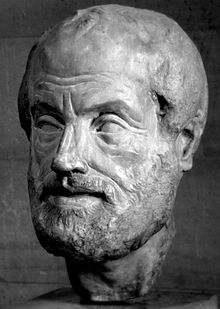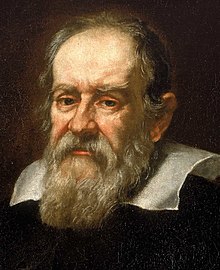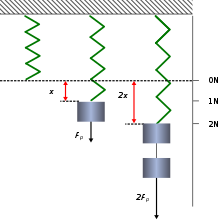Force
![]()
This article explains the concept of force in physics. For other meanings, see Force (disambiguation).
Force is a fundamental concept in physics. In classical physics, it means an action on a body that accelerates it, that is, increases or decreases its velocity or changes its direction, or that deforms it. Forces are required to do work, changing the energy of a body or a physical system.
Forces are directed physical quantities that can be represented by vectors. For two forces acting at the same point, the following applies: If they are opposite and of equal strength, they cancel each other out (force equilibrium). Otherwise, they can be combined into a resultant force, which is determined using a parallelogram of forces. Forces have different causes or effects and are sometimes named after them, such as the force of friction, the centripetal force and the weight force. Some types of forces are also named after people who have contributed significantly to their research, such as the Coriolis force, the Coulomb force or the Lorentz force.
The SI unit of force is the newton. The formula symbol of the force is usually 

The physical concept of force goes back essentially to Isaac Newton, who created the foundations of classical mechanics in the 17th century with Newton's three laws. He defined force as a change in momentum over time and identified it as the cause of every change in the state of motion of a body. He also recognized that every body that exerts a force on another experiences an oppositely directed reaction force of equal magnitude from the latter.
In certain cases, the term force is also used in a figurative sense, synonymous with interaction and detached from the representation by a mechanical force vector. The four fundamental interactions are also called the basic forces of physics. They are the cause not only of all known manifestations of forces, but of all processes known in physics. One of the four fundamental forces, gravity, is described in general relativity by the curvature of spacetime. The other three fundamental forces are explained in the standard model of particle physics by the exchange of gauge bosons, which are often also called force particles.
Word and concept history
The word force
The word force is of Ur-Germanic origin and was associated with a muscular tension.
In physical terminology, force was equated with the Latin vis at the latest in the 17th century.
The Greek word for force, δύναμις, lives on in the name of the physical subfield of dynamics, the study of motion under the influence of forces. It also underlies the unit of force dyn of the CGS system of units.
Outside of physics, force refers to
- a physical or mental quality that belongs to a particular bearer. By having this power, he is capable of certain actions and can thus achieve certain effects. Examples are: Mental power, political power, powerful voice, powerful speech, etc. Other formulations, such as exerting a force, collapsing under the force, are directed more towards the course of action and thus come closer to the physical technical term.
- Since about the end of the 18th century, force can also mean the people themselves who are the bearers of the force (armed forces, labor, teachers).
- In legal language, force already meant validity or effectiveness in Old High German, which is now only expressed in certain formulas: in/außer Kraft bleiben/treten/setzen (cf. rechtskräftig). By shortening, the preposition kraft (always with the genitive) arose from in/durch Kraft, as in kraft seines Amtes or in the formulation "... hat das deutsche Volk kraft seiner verfassungsgebenden Gewalt ..." from the preamble to the Basic Law.
The roots of the general and the mechanical concept of force
The origin of the concept of force lies (according to Max Jammer) in the human experience that an intention, once formed, can be put into action. Thus, from the very beginning, the concept of force is closely related to the causal principle: the exertion of force is the consequence of the decision, the effect produced is the consequence of the action of the force. Starting from the simplest examples, such as the voluntary movement of the parts of one's own body or of other objects, all processes that change an assumed natural state or course of things are then generally attributed to the action of forces. This includes the case of the prevention of a naturally occurring process, as when the natural falling of an object can be prevented by the application of a force. For inexplicable processes, probably since prehistoric times, certain forces have been held responsible. They were longed for or feared, and sometimes personified, invoked and worshipped in the form of gods of various ranks.
Physical forces in the narrower mechanical sense have been discussed since antiquity in connection with problems of rest and motion of bodies. Statics dealt with the question of which forces to apply in order to keep a body at rest (or in equilibrium). Already in antiquity, Archimedes discovered Archimedes' principle as the law of hydrostatic buoyancy and the law of the lever for this purpose. The equilibrium of three forces was first stated in the 16th century by Simon Stevin through the condition of the closed triangle of forces. This is equivalent to the commonly known parallelogram of forces. Stevin was also the first to derive the equilibrium condition on the inclined plane. Thus, the "four simple machines" were presented in detail in university textbooks of physics until the 19th century.
For movements of bodies, since Aristotle the view was predominant that a force was only necessary to bring a body away from its natural form of movement, so that it executes a forced movement. Natural motion was considered to be circular motion in the case of celestial bodies, and free fall in the case of terrestrial bodies. A forced movement, such as the oblique throw or the pendulum swing, ends automatically as soon as the moving force ceases to act. The action of the moving force could not occur as a remote action, but only in a mechanical way, i.e. by push, pull or friction when two bodies were in direct contact. In the case of the thrown stone, it was assumed that it was the surrounding air that propelled it forward. The force also determines the velocity of the body in motion in a way that was later interpreted as a proportionality to the velocity effected. A force acting uniformly was considered to be a rapid succession of imperceptibly small impacts.
In the Middle Ages, the Aristotelian doctrine gave rise to various theories of motion, which finally merged into the theory of impetus. According to this theory, an impetus is given to the body by a push or throw at the beginning of the movement, which drives it forward. This impetus, imprinted on and within the body, slackens with time, which is increased by the resistance of the medium, for example, air. Thus, also in the impetus theory, any movement automatically ends when the impetus is used up and the body has no more force. In contrast to Aristotle's view, there was now no longer any need for the external mover to continue to act. However, the proportionality of impressed impetus and speed, for example, was retained.
Today's physical concept of force became detached from this when, during the Renaissance in the 16th/17th century, the movements of earthly and heavenly bodies were investigated by more precise and measuring observations. It turned out (among others by Nicolaus Copernicus, Galileo Galilei, Johannes Kepler) that these movements follow simple rules, which could be explained by Isaac Newton by a common law of motion, if a new concept of force is taken as a basis. Newton's concept of force, which became the basis of classical mechanics, assumes motion entirely. He determined as the measure of impressed force the deviation from the pure inertial motion of the body, which in turn was assumed to be rectilinearly uniform. Thus weight also lost the property of being inherent in the individual body and became an impressed force, the strength of which could be determined by the acceleration due to gravity. However, Newton himself, as well as his successors, even into the 19th century, used the word force in a different sense in some passages of the text; his inertial force, for example, sometimes resembles impetus.
The modern concept of mechanical force
Galileo had also been influenced by the Aristotelian tradition, but came very close to overcoming it with his law of inertia. (p. 209) He recognized that rest and uniform horizontal motion are not physically different in nature (see Galileo invariance). Christiaan Huygens subsequently used this insight to derive the conservation of momentum and thus the laws of impact. These laws showed that uniform motion and rest do not differ in that a separate force is necessary for the mere maintenance of motion, but not for the maintenance of rest. Rather, it is only the change in the respective state of motion that makes an external influence necessary. Isaac Newton specified this influence a little later in his laws of motion. First, like Descartes before him, he defined the uninfluenced state of motion as rectilinearly uniform, and in his new term vis impressa (Latin for impressed force) he defined the speed with which this state of motion changes as the measure of force. This concept of force is still valid after further specification by Leonhard Euler and Jean-Baptiste le Rond d'Alembert; it is one of the foundations of classical mechanics. Newton himself, however, did not always use the term vis impressa only in this sense and used the same word vis, among others, also as vis inertiae for the effort of bodies to maintain their state of motion, i.e. their inertia. (S. 262)
In addition, until well into the 19th century, the word force was also used in other physical meanings that were also not covered by the Newtonian definition, e.g. in the meaning of today's concepts of momentum and energy. Until the modern concept of energy had emerged and become established, kinetic energy, for example, was referred to by the expression of living force (vis viva) coined by Gottfried Wilhelm Leibniz, which was still used in the 19th century by Hermann von Helmholtz and in the early 20th century in technical mechanics. This continues in words such as power station and motor vehicle for machines that provide energy.
Force in natural theory and natural philosophy
Force was, besides the concept specified in Newtonian mechanics, also one of the most general basic concepts of natural theory. Until the first half of the 19th century, Naturlehre formed the reservoir of the descriptive natural sciences and thus also the empirical basis of natural philosophy. In it, the forces that a thing possesses were considered to be the cause of every change or effect that it can produce. The powers of a thing were seen as the epitome of its nature, whereby nature, according to the original meaning of the word, denoted everything that was not artificially produced, i.e. by human art. Thus, in the theory of nature, a cause in the form of a constantly acting force had to be given even for the pure change in the position of a body. In the case of uniform rectilinear motion, this was an inertial force inherent in the body, which must not be confused with the modern concept of an inertial force. An acceleration or change of direction was then only possible through the simultaneous action of an additional second force. This concept of force, which ultimately emerged from ancient philosophy, fitted well with the everyday understanding, but was incompatible with Newtonian mechanics. Nevertheless, it can be found in Germany even in physics textbooks until late in the 19th century, two hundred years after Newton and one hundred years after Newtonian mechanics had established itself through its indisputable successes and had thus developed into the first universally recognised exact natural science.
Critique of the concept of mechanical force
Newtonian mechanics and especially its concept of force were criticized from the beginning on various grounds. For one thing, it could not be used to explain phenomena from first principles in the way that natural philosophy (and philosophy in general) was expected to do at the time. Force appeared in Newtonian mechanics as a useful but merely mathematical auxiliary concept for the analysis and description of movements, which, however, tended to leave the true causes hidden. Newton himself had wanted to prevent this criticism with the sentence "I make no hypotheses about this" ("Hypotheses non fingo", in his main work Philosophiae Naturalis Principia Mathematica). In addition, ambiguities in the relationship between the accelerating force (vis impressa) and the inertial force (vis inertiae) were criticized - partly rightly so. In the romantic natural philosophy of German idealism (Friedrich Schelling, Georg Friedrich Hegel), this criticism led at the beginning of the 19th century to a persistent, fundamental rejection of modern natural science of the kind founded by Newton.
A second counter-argument was that Newton's concept of force meant that gravity had to be understood as a remote effect that could penetrate absolutely empty space. Newton himself strongly objected to this conclusion, because it was in contrast to the traditional view (e.g. that of Descartes) that no body could have an effect where it was not located. Even Leonhard Euler considered the possibility of such a remote effect to be an absurd assumption.
Furthermore, it was objected in the late 19th century (Ernst Mach, Gustav Kirchhoff, Heinrich Hertz) that the origin of the Newtonian concept of force lay in the environment of the conceptual pair cause-effect, which was completely shaped by the human conception of events. Therefore, the concept of force should not be one of the basic concepts in mechanics, but should even be eliminated altogether if possible. That this is indeed possible had been shown by the development of classical mechanics by (among others) Lagrange and Hamilton, according to which knowledge of the formulae for the kinetic and potential energy of a mechanical system is sufficient to determine its equations of motion completely. This path has been followed by modern quantum mechanics and quantum field theory. Here force - if this term still appears at all in the Newtonian sense - and even potential energy are not fundamental terms, but are derived as effective quantities under certain conditions characteristic of classical physics. In technical mechanics, on the other hand, the central role of force remained unchallenged.
fundamental forces of physics
Fundamental for the derivation of the force as an effective quantity is in today's quantum field theory the creation and annihilation of one elementary particle by another due to one of the fundamental interactions. Among the conditions that must be met in this process is, in any case, the conservation of total momentum and total energy. All in all, this comes quite close to the earlier picture that mechanical force is a consequence of small collisions. In the extended sense of the word force, these fundamental interactions, together with gravitation, are also called the basic forces of nature; all physical processes known between bodies can be traced back to them.

Aristotle

Galileo Galilei
Measurement of forces
→ Main article: Force measurement
A force can be determined via a displacement-time measurement if it causes an acceleration. According to Newton's second law, for bodies with constant mass 



A force can be determined in various ways by the deformation it causes. In school lessons and in some simple applications, forces are measured with so-called spring force gauges via the change in length of helical springs. This makes use of Hooke's law, according to which the extension of suitable springs is proportional to the force exerted: It is 


The law of leverage can also be used. With it, an unknown force can be determined by comparison with a known force, for example the weight of a mass. In the simplest case, a scale is used whose display can be converted into the acting force with the help of the known acceleration due to gravity .
With the atomic force microscope, forces on a small leaf spring of up to about 1 pN can be detected. This can be used for the examination of surfaces. Forces up to the range of about 
See also: magnitude of forces
Questions and Answers
Q: What is a force?
A: A force is a push or pull between objects. It is an interaction that occurs when one object acts on another and its action is matched by a reaction from the other object.
Q: How does Newton's third law explain forces?
A: Newton's third law states that action and reaction are "equal and opposite" (matched). This means that when one object acts on another, the second object will react in an equal but opposite way.
Q: What types of objects do different forces act between?
A: Different forces act between different sorts of objects. For example, gravity acts between objects with mass like the sun and earth, while electromagnetic force acts between objects with charge like electrons and atoms.
Q: How does a force change the state of an object?
A: A force changes the state of an object by causing it to be pushed or pulled in a certain direction which changes its momentum, accelerates it, adds to its overall pressure, changes its direction or shape in some other way.
Q: How is the strength of a force measured?
A: The strength of a force is measured in Newtons (N).
Q: How many fundamental forces are there in physics?
A: There are four fundamental forces in physics.
Q: In what ways can forces affect objects?
A: Forces can affect objects by pushing them up, pulling them down, pushing them to the side or changing their motion or shape in some other way.
Search within the encyclopedia


